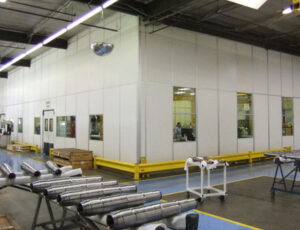Understanding CMM Room Standards by machineenclosure.com
Navigating the Precision Universe: Understanding CMM Room Standards
In the intricate world of modular building enclosures, particularly those tailored for precision measurement and quality control, Coordinate Measuring Machine (CMM) rooms hold a place of paramount importance. These specialized environments are designed to house CMMs, the sophisticated instruments used to measure the physical geometrical characteristics of an object. As an expert in environments, production workflows, and process optimization, I’ll guide you through the critical standards and considerations that define the efficacy and reliability of CMM rooms.
The Role of CMM Rooms in Manufacturing Precision
CMM rooms are more than just spaces; they are precision-controlled environments that ensure the accuracy and repeatability of measurements critical to high-quality manufacturing. The standards governing these rooms are meticulously crafted to maintain conditions that allow CMMs to operate at their peak performance, thereby ensuring the integrity of the measurement data they produce.
Key Standards for CMM Rooms
- Temperature Control: One of the most critical factors in a CMM room is the maintenance of a constant temperature. Most CMM rooms are kept at 20°C (68°F), the standard temperature for dimensional measurement. Fluctuations in temperature can cause materials to expand or contract, leading to measurement inaccuracies. The standard tolerance for temperature variation is typically within ±1°C (±1.8°F) over time and space.
- Humidity Regulation: Humidity levels in CMM rooms should also be controlled, usually within the range of 40% to 60% relative humidity. Excessive humidity can lead to condensation on the equipment and the parts being measured, while too little humidity can generate static electricity, both of which can affect measurement accuracy.
- Vibration Isolation: CMMs are sensitive to vibrations, which can originate from both internal sources, like HVAC systems, and external sources, such as nearby machinery or traffic. CMM rooms are often equipped with vibration isolation systems to minimize these effects, ensuring the stability required for precise measurements.
- Air Quality and Cleanliness: High levels of cleanliness are essential to prevent contamination of the CMM and the components being measured. Air filtration systems are used to maintain clean air, and the room’s design often includes features that minimize dust and debris.
- Lighting: Proper lighting is crucial not only for the operation of the CMM but also for the comfort and efficiency of the operators. The lighting should be uniform, without causing glare or shadows that could affect the measurement process.
Design Considerations for Optimal CMM Rooms
Creating an effective CMM room involves more than adhering to standards; it requires a holistic approach to design that considers the interplay between various environmental factors and their impact on measurement accuracy:
- Architectural Integrity: The construction materials and design of the CMM room should support the stringent environmental controls required. This includes considerations for thermal insulation, structural stability, and the integration of specialized systems for temperature, humidity, and vibration control.
- Workflow Efficiency: The layout of the CMM room should facilitate efficient workflows, with careful consideration given to the placement of the CMM, workstations, and storage for measuring artifacts and calibration equipment. This ensures smooth operation and minimizes the risk of introducing errors into the measurement process.
- Scalability and Flexibility: As manufacturing processes evolve, so too may the requirements of the CMM room. Designing with modularity and flexibility in mind allows for future adaptations without compromising the integrity of the controlled environment.
- Operator Comfort and Safety: While the primary focus of a CMM room is on maintaining optimal conditions for measurement accuracy, the well-being of the operators is also a key consideration. Ergonomic design, adequate lighting, and proper ventilation all contribute to a safe and comfortable working environment.
Conclusion
CMM rooms are critical components in the quest for manufacturing excellence, embodying the convergence of precision engineering and controlled environments. Understanding and adhering to the standards that govern these rooms is essential for ensuring the accuracy and reliability of measurements that, in turn, drive quality and innovation in manufacturing. As we continue to push the boundaries of what is possible in modular building enclosures, the principles underlying the design and operation of CMM rooms will remain a beacon of precision and excellence in the manufacturing landscape.

CNC Enclosure from Machine Enclosure by Allied Modular

